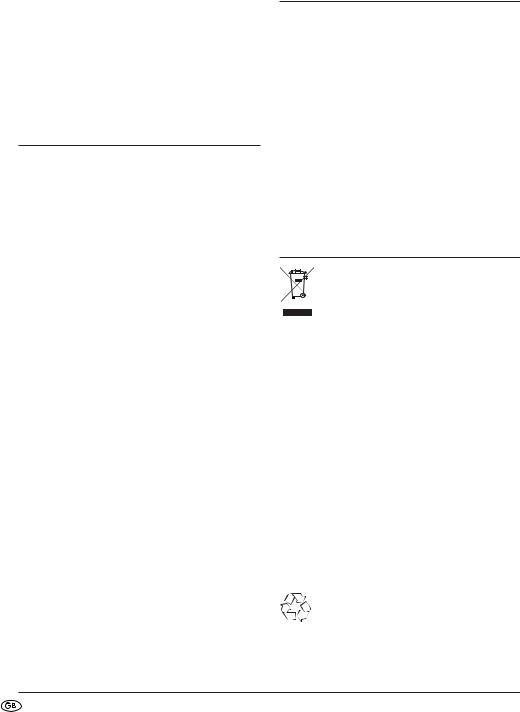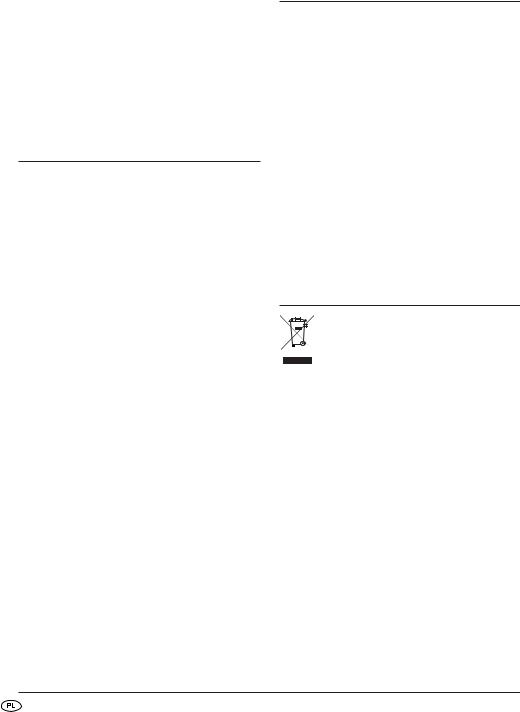Tronic TLG 1000 A1 User Manual [cs, en, pl, de]

|
|
|
|
|
|
|
|
|
|
|
|
|
|
|
|
4 |
All-Purpose Battery Charger TLG 1000 A1 |
||
|
|
|
|
All-Purpose Battery Charger
Operating instructions
Univerzális akkutöltő
Használati utasítás
Univerzální nabíječka baterií
Návod k obsluze
Univerzalni punjač baterija
Upute za upotrebu
KOMPERNASS GMBH
BURGSTRASSE 21 · D-44867 BOCHUM
www.kompernass.com
ID-Nr.: TLG 1000 A1-02/10-V3
Uniwersalna ładowarka
Instrukcja obsługi
Univerzalni polnilec baterij
Navodila za uporabo
Univerzálna nabíjačka akumulátorov
Návod na obsluhu
Universal-Akkuladegerät
Bedienungsanleitung

TLG 1000 A1
1
5 |
6 |
1 |
2 |
3 |
4 |
|
2 |
|
3

CONTENT |
PAGE |
|
|
Intended Use |
2 |
|
|
Items supplied |
2 |
|
|
Description of the appliance |
2 |
|
|
Technical data |
2 |
|
|
Safety instructions |
2 |
|
|
Commissioning |
4 |
|
|
Charging batteries |
4 |
Calculating the average charging time . . . . . . . . . . . . . . . . . . . . . . . . . . . . . . . . . . . . . . . . . .5 Automatic charging control/Retention charging . . . . . . . . . . . . . . . . . . . . . . . . . . . . . . . . . . .5 Timer control . . . . . . . . . . . . . . . . . . . . . . . . . . . . . . . . . . . . . . . . . . . . . . . . . . . . . . . . . . . . . . .6
Troubleshooting |
6 |
|
|
Cleaning |
6 |
|
|
Disposal |
6 |
|
|
Warranty & Service |
7 |
|
|
Importer |
7 |
Read the operating instructions carefully before using the appliance for the first time and preserve this booklet for later reference. Pass the manual on to whomsoever might acquire the appliance at a later date.
- 1 -

ALL-PURPOSE BATTERY CHARGER
Intended Use
The All-Purpose Battery Charger is intended exclusively for:
•for the charging of rechargeable Ni-Cd and Ni-MH batteries with the sizes AAA/AA/C/D and 9 V block batteries to standard commercial rating capacities.
•domestic use only, it is not intended for commercial applications.
Items supplied
•All-Purpose Battery Charger
•Operating manual
Description of the appliance
q Charging slots for 9 V Block batteries (Charging slots 5 and 6; see fold-out side)
w Charging slots for AAA / AA / C / D batteries (Charging slots 1 to 4; see fold-out side)
e LEDs (Operating status indicator)
Technical data
Input Voltage: |
AC 100 - 240 V ~ |
||||
|
60/50 Hz |
||||
Power consumption: |
350 mA |
||||
Protection class: |
II / |
||||
Operating temperature: |
0°C - 25°C |
||||
Storage temperature: |
-20°C - 50°C |
||||
Output voltages: |
|
|
|
|
|
|
6 x 1.4 V |
|
|
||
|
|
||||
|
(Charging slots 1-4) |
||||
|
2 x 9 V |
|
|
|
|
|
|
|
|||
|
(Charging slots 5-6) |
||||
Charging currents:
6 x 400 mA (Type AAA)
6 x 1000 mA (Type AA)
4 x 1000 mA (Types C or D)
2 x 70 mA (9 V Block battery)
Safety instructions
 Fire hazard!
Fire hazard!
Do not place the Battery Charger:
•where it would be subject to direct sunlight.
It could happen that the Battery Charger overheats and becomes irreparably damaged.
•in close adjacency to sources of heat. This includes for example ovens, fan heaters and similar appliances, as well as the ventilation openings of electrical devices. The Battery Charger could be irreparably damaged.
•in damp environments or in the vicinity of water. Moisture could permeate into the Battery Charger. There would then be the danger of receiving an electric shock and or causing a fire!
•Only charge rechargable batteries of the types „Ni-Cd“ and „Ni-MH“. NEVER recharge batteries of other types or non-rechargable batteries. These are not suitable for recharging. Batteries not suitable for recharging can overheat and explode. It could irreparably damage the Battery Charger and the inserted batteries. There is also a risk of personal injury!
- 2 -

 Danger of electrical shock!
Danger of electrical shock!
Do not place the Battery Charger:
•in the close vicinity of water, e. g. baths and swimming pools. Should water permeate into the Battery Charger, the appliance could be irreparably damaged.
•Remove the power cable from the plug socket before cleaning the Battery Charger. You can thus avoid an electric shock. Should water or moisture permeate the Battery Charger despite observing all precautions, immediately remove the power cable from the plug socket.
This device suitable only for use indoors.
 Injury hazard!
Injury hazard!
•Always store batteries out of the reach of children! There is a danger that children could swallow batteries! Due to the poisonous content of batteries there is a danger to life!
•When charging batteries never leave the Battery Charger unsupervised.
•The batteries could become hot during charging. NEVER touch hot batteries! There is a risk of being burnt! After charging batteries, first of all remove the power cable of the Battery Charger from the plug socket. Then allow the batteries to cool down before removing them from the Battery Charger.
•Should the power cable be defective, immediately arrange for it to be replaced by a service partner to avoid the risk of injury.
•The Battery Charger does not contain any userserviceable components. Should you open the housing of the Battery Charger, the warranty expires! Should repairs be needed, contact one of our service partners in your area.
•No liability or warranty will be accepted for damage caused by opening the appliance housing, repairs attempted by non-qualified persons or improper use of the Battery Charger!
•Leakage of battery acids can occur, especially with old batteries. You should remove all batteries from the Battery Charger if you do not intend to use it for an extended period. You can thus protect the Battery Charger from leaking battery acids.
•This appliance is not intended for use by persons (including children) with reduced physical, sensorial or mental capabilities, or lack of experience and knowledge, unless they have been given supervision or instruction concerning use of the appliance by a person responsible for their safety.
•Children should be supervised to ensure that they do not play with the appliance.
Interaction with batteries
•Do not use damaged (corroded) batteries.
•Should batteries leak, avoid skin contact with them. This leads to skin irritation.
•Should a battery leak into the Battery Charger, clean it with a dry cloth. Wear protective gloves!
- 3 -

Commissioning
•Before taking the Battery Charger into use, check that all items are complete/available and free of visible damage.
•Place the Battery Charger on a straight, level, scratch and slip resistant surface.
 Notice:
Notice:
This appliance is equipped with non-slip rubber feet. As furniture surfaces may be made of a variety of materials and are treated with many different types of cleaning agents, it cannot be completely ruled out that some substances contain ingredients which may corrode the rubber feet and soften them. If possible, place an anti-slip material under the device.
•Compare the technical data with that of your current mains power supplier. If they are the same, connect the power cable to a mains power socket. The LEDs blink red three times. The Battery Charger is now ready for use.
Charging batteries
 Danger!
Danger!
Charge exclusively rechargable batteries of the types „Ni-Cd“ and „Ni-MH“.
NEVER recharge batteries of other types or nonrechargable batteries. These are not suitable for recharging. They could irreparably damage the Battery Charger and the inserted batteries. There is also the danger of a fire as well as an explosion!
 Notice:
Notice:
Ensure that the batteries are inserted into the charging slots in accordance with their polarities. Otherwise, the batteries will not be charged.
•Insert the batteries into the charging slots.
•Press the 9 V Block batteries into the charging slot until they audibly engage.
1 to 8 batteries can be individually charged:
•4 x Type C or Type D batteries in the charging slots 1 to 4, with additionally 2 x Type 9 Volt
Block batteries in the charging slots 5 and 6.
or
•6 x Type AA or AAA batteries in the charging slots 1 to 4, with additionally 2 x Type 9 Volt Block batteries in the charging slots 5 and 6.
•The charging process now begins. The Battery Charger has an LED for each charging slot. The LEDs of the charging slots indicate the charge state of the battery they contain.
•In the first 5 seconds the Battery Charger carries out a capacity test:
-The LED of the charging slot glows green: The battery capacity lies over 90 %.
-The LED of the charging slot glows orange:
The battery capacity lies between 80 % - 90 %.
-The LED of the charging slot glows red:
The battery capacity lies under 80 %. |
|
- The LED of the charging slot blinks red |
: |
The battery is not properly inserted into the |
|
charging slot or is defect. |
|
When the battery capacity has been determined, the charging process begins.
- 4 -

The various indicators have the following meanings:
-The LED blinks alternatively red and green: The batteries are being charged and discharged alternately. (Refresh function: With this, older batteries or batteries that have been stored for a long time will be refreshed.)
-



 The LED blinks green:
The LED blinks green:
The batteries are being charged by a batterypreserving impulse charge.
- The LED continuously glows red:
The LED continuously glows red:
The batteries are being charged with the maximum charge current.
- The LED continuously glows green:
The LED continuously glows green:
The batteries are fully charged and the Battery Charger has switched to a trickle charge.
 Notice:
Notice:
Should Type C or D batteries be charged in the outer charging slots, the operating condition is displayed by the respective outer LEDs.
 Warning!
Warning!
The batteries could become hot during charging. NEVER touch hot batteries! There is a danger of being burnt!
•Remove the power cable of the Battery Charger from the plug socket and allow the batteries to
cool down.
Afterwards you can remove the charged batteries from the Battery Charger.
Calculating the average charging time
Dependant on the type, age and remaining battery charge, hence the charging process takes different lengths of time. The average charging times can be calculated using the following formula.
Note, however, that the times calculated are only indicative.
Current time (Min.) =
Capacity of the battery (mAh) x 1,5 x 60 Charging current of the appliance (mA)
Automatic charging control/ Retention charging
This Battery Charger controls the charging time for rechargable batteries of the types Ni-Cd and Ni-MH separately. This control is based on the –∆ U („minus Delta U“) calculation.
In mathematics, with Delta ∆ differences are described.
„Minus Delta U“ in this case means a negative voltage difference.
This charge identification makes itself useful in the following effects:
Should a battery be charged with a constant current, its voltage rises continuously. When the battery is full, its voltage reaches a maximum and falls lightly with further current flow. This light fall in voltage is recognised by the charging electronics and the charge process is terminated. The Battery Charger automatically switches to „Retention charging“. This means that the batteries are no longer being charged with continuous power, but with short power impulses instead. This counteracts the process of self-discharge, thus retaining the batteries in a fully charged condition.
- 5 -

Timer control
In addition, this charger is fitted with a timer control, which after 17 hours automatically switches over to trickle charge. This serves as additional protection against overcharging should the charge terminating device not respond, due to a possibly defective battery.
Troubleshooting
The Battery Charger displays no functions
•Check to see if the power cable is correctly inserted into the power socket.
•Check to see if the power socket is „live“. To do this, connect a different, functioning electrical appliance to the socket.
The inserted batteries are not being charged
•Check that the batteries are being inserted in accord with their polarity.
•Check that batteries suitable for charging have been inserted into the Battery Charger. Suitable for charging are exclusively rechargable Ni-Cd and Ni-MH batteries of the types AAA/AA/C/D and 9V Block batteries.
•Remove the power cable from the power socket and allow the appliance to cool down, as the temperature monitoring has possibly activated itself. Temperature monitoring ensures that the charging process is broken off as soon as a battery reaches an excessively high temperature.
Other malfunctions
Make contact with one of our service partners close to you if:
•the malfunction cannot be corrected as described above,
•or, when operating the Battery Charger, other malfunctions occur.
Cleaning
Danger! Disconnect the power cable before cleaning. There is the risk of receiving an electric shock! Ensure that moisture cannot penetrate into the device during cleaning!
Clean the housing of the Battery Charger only with a dry cloth. For stubborn soiling use a slightly damp cloth.
Under no circumstances use moisture to clean the interior of the charger. Instead, use a soft and clean brush to clean the insides. DO NOT use abrasive or chemical cleaning agents.
Disposal
Do not dispose of the appliance in your
normal domestic waste. This product is
subject to the European guideline 2002/96/EC.
Dispose of the appliance through an approved dis-posal centre or at your community waste facility. Observe the currently applicable regulations.
In case of doubt, please contact your waste disposal centre.
Battery disposal!
Batteries may not be disposed of with normal domestic waste. All consumers are statutorily obliged to dispose of batteries at the collection point in their community/district or with the original supplier.
The purpose of this obligation is to ensure that batteries can be disposed of in an environmentally friendly manner. Only dispose of batteries when they are fully discharged.
Dispose of all packaging materials in an environmentally responsible manner.
- 6 -

Warranty & Service |
|
Importer |
The warranty for this appliance is for 3 years from |
|
KOMPERNASS GMBH |
the date of purchase. The appliance has been |
|
BURGSTRASSE 21 |
manufactured with care and meticulously examined |
|
44867 BOCHUM, GERMANY |
before delivery. Please retain your receipt as proof |
|
|
of purchase. In the event of a warranty claim, please |
|
www.kompernass.com |
make contact by telephone with our Service Depart- |
|
|
ment. Only in this way can a post-free despatch for |
|
|
your goods be assured. |
|
|
The warranty covers only claims for material and |
|
|
maufacturing defects, but not for transport damage, |
|
|
for wearing parts or for damage to fragile compo- |
|
|
nents, e.g. buttons or batteries. This product is for |
|
|
private use only and is not intended for commercial |
|
|
use. The warranty is void in the case of abusive and |
|
|
improper handling, use of force and internal tampe- |
|
|
ring not carried out by our authorized service |
|
|
branch. Your statutory rights are not restricted in |
|
|
any way by this warranty. |
|
|
The warranty period will not be extended by repairs |
|
|
made under warranty. This applies also to replaced |
|
|
and repaired parts. Any damage and defects extant |
|
|
on purchase must be reported immediately after |
|
|
unpacking the appliance, at the latest, two days |
|
|
after the purchase date. Repairs made after the |
|
|
expiration of the warranty period are subject to |
|
|
payment. |
|
|
DES UK LTD |
|
|
Tel.: 0871 5000 700 (£ 0.10 / minute) |
|
|
e-mail: support.uk@kompernass.com |
|
|
Kompernass Service Ireland |
|
|
Tel: 1850 930 412 (0,082 EUR/Min.) |
|
|
Standard call rates apply. Mobile operators may vary. |
|
|
e-mail: support.ie@kompernass.com |
|
|
- 7 -

- 8 -

SPIS TREŚCI |
STRONA |
|
|
Cel zastosowania |
10 |
|
|
Zakres dostawy |
10 |
|
|
Opis urządzenia |
10 |
|
|
Dane techniczne |
10 |
|
|
Wskazówki bezpieczeństwa |
10 |
|
|
Uruchomienie |
12 |
|
|
Ładowanie akumulatorów |
12 |
Obliczanie średniego czasu ładowania . . . . . . . . . . . . . . . . . . . . . . . . . . . . . . . . . . . . . . . .13 Automatyczna kontrola ładowania/ładowanie konserwacyjne . . . . . . . . . . . . . . . . . . . . . .13 Sterowanie zegarowe . . . . . . . . . . . . . . . . . . . . . . . . . . . . . . . . . . . . . . . . . . . . . . . . . . . . . .14
Usuwanie usterek |
14 |
|
|
Czyszczenie |
14 |
|
|
Utylizacja |
14 |
|
|
Gwarancja i serwis |
15 |
|
|
Importer |
15 |
Niniejszą instrukcję należy zachować, aby móc także później z niej skorzystać, w przypadku przekazywania urządzenia osobom trzecim należy przekazać także instrukcję!
- 9 -

UNIWERSALNA ŁADOWARKA
Cel zastosowania
Uniwersalna ładowarka jest przeznaczona wyłącznie do następujących zadań:
•do ładowania akumulatorów Ni-Cd i Ni-MH o rozmiarach AAA/AA/C/D i blokowych 9 V o dostępnych w sprzedaży pojemnościach.
•do prywatnego, domowego użytku.
Zakres dostawy
•Uniwersalna ładowarka
•Instrukcja obsługi
Opis urządzenia
q Kieszenie do ładowania akumulatorów
9 V (kieszenie 5 i 6; Patrz strona rozkładana) w Kieszenie do ładowania akumulatorów typu
AAA/AA/C/D (kieszenie od 1 do 4; Patrz strona rozkładana)
e Diody (Wskazanie stanu pracy)
Dane techniczne
Napięcie wejściowe: |
AC 100–240 V ~ 60/50 Hz |
||
Pobór prądu: |
350 mA |
||
Klasa ochrony: |
II / |
||
Temperatura robocza: 0°C - 25°C |
|||
Temperatura |
|
|
|
przechowywania: |
-20°C - 50°C |
||
Napięcia wyjściowe: |
|
|
|
|
6 x 1,4 V |
|
|
|
|
||
|
(kieszenie ładowania 1-4) |
||
2 x 9 V
(kieszenie ładowania 5-6)
Prądy ładowania:
6 x 400 mA (typ AAA)
6 x 1000 mA (typ AA)
4 x 1000 mA (typ C lub D)
2 x 70 mA (typ blokowy 9 V)
Wskazówki bezpieczeństwa
 Niebezpieczeństwo pożaru!
Niebezpieczeństwo pożaru!
Nie stawiaj ładowarki:
•w miejscach narażonych na bezpośrednie działanie promieni słonecznych. Ciepło promieni słonecznych mogłoby doprowadzić do przegrzania ładowarki i jej trwałego uszkodzenia.
•w bezpośrednim sąsiedztwie źródeł gorąca.
Są nimi np. piece, farelki lub inne podobne urządzenia oraz otwory wentylacyjne innych urządzeń. Ciepło odprowadzane przez urządzenia mogłoby doprowadzić do przegrzania ładowarki i jej trwałego uszkodzenia.
•w wilgotnym otoczeniu lub w pobliżu wody. W przeciwnym razie do środka ładowarki
może przedostać się woda. Istnieje zagrożenie porażenia prądem elektrycznym i spowodowania pożaru!
•Do ładowania nadają się wyłącznie akumulatory „Ni-Cd” i „Ni-MH”. Nie próbuj nigdy ładować akumulatorów innych typów ani baterii jednorazowego użytku. Nie nadają się one do ładowania. Akumulatory nieprzystosowane do ładowania mogą się
przegrzać i wybuchnąć. Ładowarka uniwersalna oraz znajdujące się w niej akumulatory mogą ulej trwałemu uszkodzeniu. Zagrożenie odniesienia obrażeń!
- 10 -

 Zagrożenie porażenia prądem!
Zagrożenie porażenia prądem!
Nie stawiaj ładowarki:
•w bezpośrednim sąsiedztwie wody, np. na wannie lub na brzegu basenu. Przedostanie się wody do środka ładowarki może doprowadzić do jej trwałego uszkodzenia.
•Przed przystąpieniem do czyszczenia wyciągnij kabel ładowarki z gniazdka zasilania. Dzięki temu unikniesz zagrożenia porażenia prądem elektrycznym. Jeśli mimo zastosowania wszelkich możliwych środków ostrożności
do środka ładowarki przedostanie się woda lub wilgoć, wyciągnij natychmiast wtyczkę z gniazdka zasilania.
Urządzenie jest przeznaczony wyłącznie do używania wewnątrz pomieszczeń.
 Niebezpieczeństwo skaleczenia!
Niebezpieczeństwo skaleczenia!
•Akumulatory przechowuj zawsze w miejscu niedostępnym dla dzieci! Dzieci mogą przez nieostrożność połknąć akumulator! Znajdujące się w środku akumulatorów związki trujące stanowią śmiertelne zagrożenie!
•Podczas trwania ładowania nigdy nie zostawiaj ładowarki bez nadzoru.
•Akumulatory podczas ładowania mogą się nagrzać do wysokiej temperatury. Nigdy nie dotykaj gorących akumulatorów! Dotknięcie gorącego akumulatora grozi poparzeniem! Po zakończeniu ładowania najpierw wyciągnij wtyczkę kabla ładowarki z gniazdka, a następnie odczekaj do ostygnięcia akumulatorów i wyjmij je z ładowarki.
•Aby uniknąć zagrożeń spowodowanych uszkodzonym kablem sieciowym, jego wymianę powierzaj zawsze autoryzowanemu serwisowi.
•Ładowarka uniwersalna nie zawiera żadnych elementów, które nadawałyby się do konserwacji przez użytkownika. Samodzielne otwarcie obudowy ładowarki powoduje unieważnienie gwarancji! W celu dokonania naprawy należy zwrócić się do najbliższego punktu serwisowego producenta.
•Producent nie ponosi odpowiedzialności/ nie uznaje gwarancji w przypadku szkód
spwodowanych otwarciem obudowy, próbami naprawiania ładowarki przez niewykwalifikowane osoby lub użytkowaniem niezgodnym z przeznaczeniem!
•W przypadku ładowania starszych akumulatorów występuje zwiększone zagrożenie kwasu. Dlatego w przypadku dłuższych przerw w używaniu ładowarki wyjmuj wszystkie akumulatory. W ten sposób uchronisz ładowarkę uniwersalną przed uszkodzeniami spowodowanymi wylaniem kwasu.
•Nie zezwalaj na użytkowanie tostera przez osoby (w tym dzieci) upośledzone umysłowo lub fizycznie lub nie posiadające odpowiedniej wiedzy i doświadczenia w bezpiecznym użytkowaniu urządzeń, bądź jeśli nie zostały one uprzednio odpowiednio poinstrowane lub przeszkolone.
•Poinformuj dzieci o zagrożeniach związanych z użytkowaniem urządzenia i nie pozwól dzieciom bawić się urządzeniem.
Postępowanie z akumulatorami
•Nigdy nie używaj uszkodzonych (skorodowanych) akumulatorów.
•W przypadku wylania kwasu z akumulatorów, unikaj kontaktu ze skórą. Kwas wywołuje podrażnienia skóry.
•Rozlany kwas z akumulatora wytrzyj z powierzchni ładowarki suchą szmatką. Diody trzykrotnie pulsują żółtym światłem. Załóż rękawice ochronne!
- 11 -

Uruchomienie
•Przed przystąpieniem do uruchomienia sprawdź, czy w opakowaniu znajdują się wszystkie elementy zestawu, oraz czy podczas transportu nie doszło do uszkodzenia ładowarki.
•Ustaw ładowarkę uniwersalną na równym, płaskim i stabilnym podłożu.
 Wskazówka:
Wskazówka:
Urządzenie posiada antypoślizgowe gumowe nóżki. Ponieważ powierzchnie mebli wykonywane są z różnych materiałów i do ich pielęgnacji stosowane są różne środki nie można całkowicie wykluczyć, iż niektóre środki zawierają substancje mogące niszczyć nóżki. W stosownym przypadku pod nóżki urządzenia należy podłożyć antypoślizgową podkładkę.
•Porównaj dane techniczne z napięciem dostępnym w sieci elektrycznej. Jeżeli napięcia będą się zgadzały, podłącz kabel sieciowy do gniazdka. Diody migają trzy razy czerwonym kolorem. Ładowarka jest gotowa do pracy.
Ładowanie akumulatorów
 Niebezpieczeństwo!
Niebezpieczeństwo!
Do ładowania nadają się wyłącznie akumulatory „Ni-Cd” i „Ni-MH”. Nie próbuj nigdy ładować akumulatorów innych typów ani baterii jednorazowego użytku. Nie nadają się one do ładowania. Ładowarka uniwersalna oraz znajdujące się w niej akumulatory mogą ulej trwałemu uszkodzeniu. Występuje zagrożenie spowodowania pożaru oraz wybuchu!
 Wskazówka:
Wskazówka:
Podczas wkładania akumulatorów do kieszeni ładowarki zwracaj uwagę na prawidłowe rozmieszczenie biegunów. Odwrotne włożenie akumulatora do ładowarki uniemożliwi jego naładowanie.
•Włóż akumulatory do odpowiednich kieszeni ładowarki.
•Akumulatory 9 V włóż do kieszeni ładowarki i wciśnij aż do zatrzaśnięcia.
Urządzenie pozwala na niezależne ładowanie od 1 do 8 różnych akumulatorów:
• 4 x typu C lub typu D w kieszeniach od 1 do 4 oraz dodatkowo 2 x typu blokowego 9 V w kieszeniach 5 i 6.
lub
•6 x typu AA lub AAA w kieszeniach od 1 do 4 oraz dodatkowo 2 x typ blokowego 9 V w kieszeniach 5 i 6.
•Rozpoczyna się ładowanie. W ładowarce znajduje się dioda przy każdej kieszeni. Diody zajętych kieszeni pokazują stan naładowania poszczególnych akumulatorów.
•W ciągu pierwszych 5 sekund po włożeniu akumulatora ładowarka wykonuje przyspieszony test:
-Dioda przy kieszeni ma zielony kolor: Napięcie akumulatora wynosi powyżej 90 %.
-Dioda przy kieszeni ma pomarańczowy kolor: Napięcie akumulatora wynosi od 80 % do 90 %.
-Dioda przy kieszeni ma czerwony kolor:
Napięcie akumulatora wynosi poniżej 80 %. |
|
- Dioda przy kieszeni miga czerwonym kolorem |
: |
Akumulator nie został prawidłowo włożony do |
|
kieszeni lub jest uszkodzony. |
|
Po sprawdzeniu napięcia rozpoczyna się ładowanie.
- 12 -

Poszczególne wskazania mają następujące znaczenia:
-Dioda miga na zmianę w kolorze czerwonym i pomarańczowym:
Trwa naprzemiennie ładowanie i wyładowywanie akumulatorów. (funkcja odświeżenia: spowoduje to odświeżenie starszych lub nieużywanych przez dłuższy czas akumulatorów.)
-



 Dioda miga w kolorze zielonym: Akumulatory są ładowane w ochronnym trybie impulsowym.
Dioda miga w kolorze zielonym: Akumulatory są ładowane w ochronnym trybie impulsowym.
- Dioda włączona na stałe w kolorze czerwonym:
Dioda włączona na stałe w kolorze czerwonym:
Akumulatory są ładowane maksymalnym prądem ładowania.
- Dioda włączona na stałe w kolorze zielonym: Akumulatory zostały całkowicie naładowane i ładowarka przełącza się na ładowanie podtrzymujące.
Dioda włączona na stałe w kolorze zielonym: Akumulatory zostały całkowicie naładowane i ładowarka przełącza się na ładowanie podtrzymujące.
 Wskazówka:
Wskazówka:
W przypadku ładowania akumulator typu C lub D w kieszeniach zewnętrznych, odpowiednie dioda zewnętrzna wskazuje stan pracy.
 Ostrzeżenie!
Ostrzeżenie!
Akumulatory podczas ładowania mogą się nagrzać do wysokiej temperatury. Nigdy nie dotykaj gorących akumulatorów! Zagrożenie odniesienia obrażeń!
•Kabel sieciowy ładowarki wyciągnij z gniazdka i odczekaj do ostygnięcia urządzenia.
Następnie naładowane akumulatory możesz wyjąć z ładowarki.
Obliczanie średniego czasu ładowania
W zależności od typu, wieku i stanu naładowania akumulatorów, ładowanie może trwać różną długość czasu. Średnie czasy ładowania można obliczyć za pomocą następującego wzoru.
Należy jednakże pamiętać, że chodzi tu o orientacyjne wartości.
Czas ładowania (min.) =
Pojemn. akumulatora (mAh) x 1,5 x 60 Prąd ładowania urządzenia (mA)
Automatyczna kontrola ładowania/ ładowanie konserwacyjne
Ta ładowarka steruje czasem ładowania oddzielnie w przypadku akumulatorów typu Ni-Cd i Ni-MH. Sterowanie to opiera się na metodzie – U („minus Delta U”).
W matematyce symbolem delta określa się różnice.
„Minus Delta U” w tym przypadku oznacza ujemną różnicę napięć.
To rozpoznawanie zakończenia ładowania wykorzystuje następujący efekt:
Napięcie prądu w przypadku ładowania akumulatora prądem stałym ciągle wzrasta. Po pełnym naładowaniu akumulatora, napięcie uzyskuje wartość maksymalną i w przypadku dalszego przewodzenia prądu nieznacznie spada. Ten niewielki spadek napięcia jest wykrywany przez układ elektroniczny ładowania powodując zakończenie ładowania. Ładowarka uniwersalna przełącza się automatycznie na „ładowanie konserwacyjne”. Oznacza to, iż do ładowania akumulatorków nie jest używany prąd stały, lecz krótkotrwałe impulsy prądu. Zapobiega to samorozładowaniu akumulatorków i utrzymuje je w stanie pełnego naładowania.
- 13 -

Sterowanie zegarowe
Ładowarka została wyposażona w funkcję sterowania zegarowego, które po upływie 17 godzin automatycznie przełącza się na ładowanie podtrzymujące. Funkcja ta stanowi dodatkową ochronę przed przeładowaniem, gdyby – z powodu np. uszkodzenia akumulatorów – nie zadziałało rozpoznawanie zakończenia ładowania.
Usuwanie usterek
Ładowarka nie wskazuje żadnej funkcji
•Sprawdź, czy kabel sieciowy został podłączony prawidłowo do gniazdka.
•Sprawdź, czy w gniazdku sieciowym płynie prąd. W tym celu podłącz do gniazdka inne urządzenie elektryczne.
Akumulatory po włożeniu do ładowarki nie ładują się
•Sprawdź, czy akumulatory zostały włożone zgodnie z rozmieszczeniem biegunów.
•Sprawdź typ akumulatorów włożonych do ładowarki. Do ładowania nadają się wyłącznie akumulatory Ni-Cd i Ni-MH typów AAA/AA/C/D i blokowe 9 V.
•Wyciągnij kabel z gniazdka sieciowego i odczekaj do ostygnięcia urządzenia, ponieważ prawdopodobnie uruchomiła się funkcja kontroli temperatury. Układ monitorowania temperatury powoduje przerwanie procesu ładowania przy zbytnim rozgrzaniu akumulatorka.
Czyszczenie
Niebezpieczeństwo! Przed przystąpieniem do czyszczenia zawsze najpierw wyjmij wtyczkę z gniazdka sieciowego. Występuje niebezpieczeństwo porażenia prądem elektrycznym! Podczas czyszczenia zwróć uwagę, by do środka urządzenia nie przedostała się wilgoć!
Obudowę ładowarki czyść wyłącznie suchą szmatką. Do usunięcia trudno zmywalnych zabrudzeń użyj lekko zwilżonej szmatki.
Nigdy nie czyść wnętrza kieszeni ładowania na mokro. Do czyszczenia używaj czystego pędzelka o miękkim włosiu. Nie używaj szorujących ani chemicznych środków czyszczących.
Utylizacja |
Urządzenia nie należy wyrzucać wraz |
z normalnymi odpadami domowymi. |
Niniejszy produkt podlega działaniom, |
przewidziamyn w przepisach dyrekty- |
wy europejskiej 2002/96/EC. |
Urządzenie należy usuwać w akredytowanych za- |
kładach utylizacji odpadów lub komunalnych zakła- |
dach utylizacji odpadów. |
Należy przestrzegać aktualnie obowiązujących |
przepisów. W razie pytań i wątpliwości odnośnie |
zasad utylizacji należy skontaktować się z najbliżs- |
zym zakładem utylizacji odpadów. |
Pozostałe usterki w działaniu
Skontaktuj się z najbliższym autoryzowanym serwisem, jeśli:
•nie po zastosowaniu opisanych sposobów naprawy nie można usunąć usterek w działaniu
•lub jeśli podczas użytkowania ładowarki wystąpią inne usterki.
Usuwanie akumulatorów
Akumulatorów nie można wyrzucać do śmieci wraz z pozostałymi odpadami domowymi. Każdy użytkownik jest ustawowo zobowiązany do składowania zużytych akumulatorów / baterii w odpowiednich punktach zbiórki, wyznaczanych przez władze miasta lub oddawania ich do punktu handlowego.
- 14 -

Ten przepis ma na celu ochronę środowiska naturalnego przed niekontrolowanym usuwaniem szkodliwych odpadów, jakimi są zużyte akumulatory i baterie.
Należy zwracać wyłącznie całkowicie rozładowane akumulatory / baterie.
 Materiał opakowaniowy należy przekazy-
Materiał opakowaniowy należy przekazy-  wać do utylizacji zgodnie z przepisami o ochronie środowiska.
wać do utylizacji zgodnie z przepisami o ochronie środowiska.
Gwarancja i serwis
Urządzenie objęte jest dwuletnią gwarancją, licząc od daty zakupu. Urządzenie zostało starannie wyprodukowane i poddane skrupulatnej kontroli przed wysyłką. Paragon należy zachować jako dowód dokonania zakupu. W przypadku roszczeń gwarancyjnych należy skontaktować się telefonicznie z serwisem. Tylko w ten sposób można zagwarantować bezpłatną wysyłkę zakupionego produktu. Gwarancja obejmuje wyłącznie wady materiałowe i fabryczne, natomiast nie obejmuje szkód powstałych podczas transportu, części ulegających zużyciu ani uszkodzeń części łatwo łamliwych, np. wyłączników, akumulatorów. Produkt przeznaczony jest wyłącznie do użytku domowego, a nie do zastosowań profesjonalnych.
Gwarancja traci ważność w przypadku niewłaściwego używania urządzenia, używania niezgodnego z przeznaczeniem, użycia siły lub ingerencji w urządzenie dokonywanej poza naszymi autoryzowanymi punktami serwisowymi. Niniejsza gwarancja nie ogranicza ustawowych praw nabywcy urządzenia.
Okres gwarancji nie ulega wydłużeniu o czas trwania usługi gwarancyjnej. Dotyczy to również wymienionych i naprawionych części. Szkody i wady zauważone już w chwili zakupu należy zgłosić od razu po rozpakowaniu, nie później niż po upływie dwóch dni od daty zakupu. Po upływie okresu gwarancyjnego wszystkie naprawy będą wykonywane płatnie.
Kompernass Service Polska
Tel.: 022 / 3972212
e-mail: support.pl@kompernass.com
Importer
KOMPERNASS GMBH BURGSTRASSE 21
44867 BOCHUM, GERMANY
www.kompernass.com
- 15 -

- 16 -

TARTALOMJEGYZÉK |
OLDALSZÁM |
Rendeltetés |
18 |
A csomag tartalma |
18 |
A készülék leírása |
18 |
Műszaki adatok |
18 |
Biztonsági utasítások |
18 |
Üzembe vétel |
20 |
Az akkumulátorok töltése |
20 |
Az átlagos töltési idő kiszámítása . . . . . . . . . . . . . . . . . . . . . . . . . . . . . . |
. . . . . . . . . . . . . . .21 |
Automatikus töltésellenőrzés/fenntartó töltés . . . . . . . . . . . . . . . . . . . . . . |
. . . . . . . . . . . . . . .21 |
Időzítő vezérlés . . . . . . . . . . . . . . . . . . . . . . . . . . . . . . . . . . . . . . . . . . . . |
. . . . . . . . . . . . . . .22 |
Működési zavarok elhárítása |
22 |
Tisztítás |
22 |
Ártalmatlanítás |
22 |
Garancia és szerviz |
23 |
Gyártja |
23 |
Őrizze meg ezt a leírást arra az esetre, ha később kérdése merülne fel. A készülék harmadik személynek történő továbbadásakor adja tovább a leírást is!
- 17 -

UNIVERZÁLIS
AKKUTÖLTŐ
Rendeltetés
Az univerzális akkutöltő kizárólag az alábbi célokra való:
•hagyományos AAA/AA/C/D és 9 V-os méretű újratölthető Ni-Cd- és Ni-MH-akkuk töltésére.
•magán, nem pedig kereskedelmi használatra.
A csomag tartalma
•Univerzális akkutöltő
•Használati útmutató
A készülék leírása
q töltőrekesz a 9 V-os blokkhoz ( 5-ös és 6-os töltőrekesz; Lásd a kihajtható oldalt.)
w AAA/AA/C/D típusú elemekhez való töltőrekesz (1–4-es töltőrekesz; Lásd a kihajtható oldalt.)
e LED-ek (üzemiállapot kijelzés)
Műszaki adatok
Bemeneti feszültség: |
AC 100–240 V ~ 60/50 Hz |
||||
Áramfelvétel: |
350 mA |
||||
Védelmi osztály: |
II / |
||||
Üzemelési hőmérséklet: 0°C - 25°C |
|||||
Tárolási hőmérséklet: |
-20°C - 50°C |
||||
Kimeneti feszültségek: |
|
|
|
|
|
|
6 x 1,4 V |
|
|
||
|
|
||||
|
(1-4. töltőhéj) |
||||
|
2 x 9 V |
|
|
|
|
|
|
|
|||
|
(5-6. töltőhéj) |
||||
Töltőáramlatok:
6 x 400 mA (AAA típusú)
6 x 1000 mA (AA típusú)
4 x 1000 mA (C vagy D típusú)
2 x 70 mA (9 V)
Biztonsági utasítások
 Tűzveszély!
Tűzveszély!
Ne helyezze az univerzális elemtöltőt:
•olyan helyre, mely közvetlen napsugárzásnak van kitéve. Máskülönben az univerzális elemtöltő túlhevülhet és helyrehozhatatlan kár keletkezhet benne.
•hőforrás közvetlen közelébe. Ilyennek számít pl. a kályha, hőlégfúvó és hasonló készülékek,
valamint más elektromos készülékek szellőzőnyílásai. Máskülönben az univerzális elemtöltőben helyrehozhatatlan kár keletkezhet.
•nedves környezetbe vagy víz közelébe. Máskülönben nedvesség juthat be az univerzális elemtöltőbe. Elektromos áramütés vagy tűz veszélye áll fenn!
•Kizárólag újratölthető „Ni-Cd“ és „Ni-MH“ típusú elemet töltsön. Soha ne töltsön más típusú elemet vagy nem újratölthető elemet. Ezek nem alkalmasak az újratöltésre. A nem tölthető elemek túlhevülhetnek és felrobbanhatnak. Az univerzális elemtöltő és a behelyezett elemek helyrehozhatatlanul megsérülhetnek. Balesetveszélyes!
- 18 -
